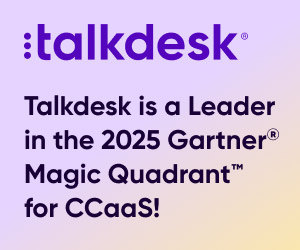Calabrio breaks down the practical steps to create a workforce management plan that actually works in today’s complex contact centre environment.
Contact centre leaders know the familiar cycle all too well: scrambling to fill unexpected scheduling gaps, watching service levels drop during surprise volume spikes, and dealing with frustrated agents who feel their work-life balance takes a backseat to operational demands.
Effective workforce management isn’t just about having enough people on the clock; it’s about having the right people with the right skills at precisely the right moments.
The difference between good and great workforce management can mean millions in saved costs, dramatically improved customer satisfaction, and perhaps most importantly, happier agents who stick around.
We’ve gathered insights from organizations that transformed their approach to scheduling and staffing, and distilled their experiences into a roadmap you can follow right now.
What Is a Workforce Management Plan?
A workforce management plan is a strategic framework that aligns staffing needs with business goals. It ensures that the right number of employees with the right skills are in the right place at the right time.
For contact centres, this means having enough agents to handle customer interactions while optimizing costs and maintaining service levels. An effective WFM plan supports both short-term operational goals and long-term strategic objectives.
The Benefits of Strategic Workforce Management
Strategic workforce management transforms how contact centres operate by creating harmony between business needs, customer expectations, and agent well-being.
When implemented correctly, a comprehensive WFM strategy significantly reduces operational costs through precise staffing that matches actual demand patterns. This eliminates expensive overstaffing while preventing the service degradation that comes with understaffing.
Customer satisfaction naturally improves as wait times decrease and first-contact resolution rates climb. With properly scheduled staff handling interactions, customers spend less time waiting and more time getting their issues resolved by the right agent with the right skills.
For agents, strategic workforce management means more than just efficient scheduling. It creates an environment where burnout decreases and engagement rises.
By implementing flexible scheduling options and self-service tools, agents gain more control over their work-life balance.
This directly addresses one of the industry’s biggest challenges, like high attrition rates that plague many contact centres.
From a business intelligence perspective, proper workforce management dramatically improves forecasting accuracy.
This ripples through the organization, enabling better budget planning, more strategic hiring decisions, and smarter resource allocation across departments.
Contact centres that implement effective workforce management strategies typically see concrete results. 15-25% improvements in schedule adherence, 10-20% reductions in overtime costs, and significant gains in both customer and agent satisfaction metrics.
Core Steps to Building Your Workforce Management Plan
Looking to build your own workforce management plan? Here are five steps that will set you up for success.
Step 1: Analyse Your Current Workforce
The foundation of any effective workforce management plan starts with a comprehensive understanding of your existing staffing situation. This analysis should go beyond simple headcount to reveal the true state of your contact centre operations.
Begin by gathering detailed data on your current staffing levels across all departments and skill groups. Document how agents are currently distributed across channels, shifts, and specialties. This mapping exercise often reveals imbalances you might not otherwise notice.
Next, collect performance metrics for individual agents and teams. Look at key indicators such as:
- Average handle time
- First-contact resolution rates
- Quality scores
- Customer satisfaction ratings
- Sales conversion rates (if applicable)
Schedule adherence data provides critical insights into how well your current workforce follows established schedules.
Low adherence often signals underlying issues with scheduling practices or agent engagement that need addressing in your WFM plan.
Don’t overlook absenteeism and turnover patterns. High rates in specific departments or shifts may indicate workload problems, leadership issues, or scheduling conflicts that your WFM plan should address.
Many contact centres discover that certain shifts consistently experience higher absenteeism, pointing to potential quality of life concerns for those time slots.
Finally, analyze peak and slow periods across different timeframes:
- Daily patterns (identify busiest hours)
- Weekly patterns (busiest days)
- Monthly and seasonal fluctuations
- Special events that impact volume
Pro tip: When evaluating your current workforce, don’t just look at numbers. Assess qualitative factors like team morale, leadership strength, and cross-training opportunities. These human elements often explain the “why” behind performance metrics.
Step 2: Forecast Demand and Workload
Accurate forecasting forms the backbone of any successful WFM plan. Poor forecasting leads to either costly overstaffing or service-damaging understaffing. Modern contact centres need sophisticated forecasting that accounts for multiple variables and channels.
Start by gathering comprehensive historical contact data across all customer interaction channels: calls, chat, email, social media, and any other touchpoints specific to your business. This multi-channel approach is essential as customer preferences continue to diversify.
Identify seasonal patterns and special events that impact volume. Most businesses experience predictable fluctuations throughout the year.
A retail contact centre might see volume double during holiday seasons, while a healthcare provider might experience surges during open enrolment periods.
Your forecast must account for growth projections and new business initiatives. Are you launching new products? Expanding into new markets? These strategic decisions directly impact staffing needs, often in ways that historical data alone can’t predict.
Don’t forget to factor in external influences like marketing campaigns, product launches, or system changes. A single television commercial can trigger a 300% increase in contact volume within minutes of airing. Your WFM plan needs to anticipate these spikes.
Our WFM software uses AI-powered forecasting to analyse these complex patterns and predict future contact volumes with significantly greater accuracy than traditional spreadsheet-based methods.
Plus, intelligent machine learning algorithms continuously improve as they process more data, making forecasts progressively more accurate over time.
Step 3: Develop Staffing Plans and Schedules
Once you understand your demand patterns, it’s time to create staffing plans that align agent availability with anticipated contact volume.
This critical step transforms forecasts into actionable schedules that balance operational needs with agent preferences.
Effective scheduling must accommodate both business requirements and agent work-life balance. Modern contact centers recognize that inflexible scheduling is a primary driver of agent attrition. At the same time, schedules must ensure service levels remain consistently high.
Include buffer time for unexpected demand spikes in your scheduling strategy. The most precise forecasts still can’t predict every variable. Building in 5-10% flexibility allows your operation to absorb unexpected volume increases without service degradation.
Schedule the right skill sets during the right periods. Not all agents have identical capabilities, and customer needs vary throughout the day.
Complex technical issues might peak during business hours, while general inquiries dominate evenings. Your schedule should reflect these patterns by matching agent skills to anticipated contact types.
Balance full-time and part-time resources strategically. Part-time staff can provide valuable coverage during peak periods without the expense of full-time agents during slower times. Many contact centers find that a mix of 70% full-time and 30% part-time staff offers optimal flexibility.
Don’t forget to allocate time for essential non-call activities like breaks, training, coaching, and team meetings. Agents need this time to recharge and develop, but it must be scheduled strategically to minimize impact on service levels.
Step 4: Implement Real-Time Management
Even the most meticulously crafted workforce management plan requires real-time adjustments. Contact volumes fluctuate, agents call in sick, and unexpected events occur. Successful contact centres establish robust real-time management systems to handle these inevitable variations.
Implement continuous monitoring of schedule adherence to track whether agents are following their assigned schedules.
This isn’t about micromanagement; it’s about understanding where the day’s reality diverges from the plan so you can make informed adjustments.
Track real-time service levels and wait times across all channels. These metrics serve as early warning signals, allowing you to intervene before small issues become major service failures. Set thresholds that trigger supervisor notifications when metrics are approached concerning levels.
Develop systematic processes for making intraday adjustments when volume differs from the forecast.
This might include:
- Offering voluntary time off during unexpectedly slow periods
- Requesting overtime during volume spikes
- Shifting agents between channels based on real-time demand
- Temporarily adjusting handle time expectations when queues grow
Meanwhile, ensure you can provide agents with consistent, timely feedback on performance. Agents who can see their metrics in relation to team goals and service level targets can self-correct before supervisor intervention becomes necessary.
Our real-time adherence monitoring enables supervisors to identify issues as they happen, not after the fact. The system provides visual alerts when agents are out of adherence, allowing for immediate coaching opportunities rather than retroactive discussions.
Step 5: Measure, Analyse, and Improve
Workforce management is never a “set it and forget it” process. It requires continuous evaluation and refinement based on actual results. Establish a systematic approach to measuring performance and identifying opportunities for improvement.
Create a regular cadence for comparing forecast accuracy against actual volume. Track both overall accuracy and patterns in the variances. Are you consistently underestimating Monday morning volume?
Do forecasts for certain channels show greater variance than others? These patterns provide valuable insights for refining your forecasting methodology.
Evaluate Schedule Effectiveness and Adherence Regularly
Look beyond simple adherence percentages to understand the root causes of non-adherence. Are agents missing adherence during specific parts of the day?
Are certain activities consistently taking longer than scheduled? This detailed analysis reveals actionable improvements.
Assess Agent Performance and Satisfaction
The most successful WFM plans balance operational efficiency with agent well-being. Regular surveys and communication can reveal opportunities to improve scheduling practices in ways that benefit both the business and agents.
Identify Bottlenecks or Inefficiencies in Your Processes
Are handoffs between departments causing delays? Do certain transaction types take longer than necessary? Your WFM strategy should address these operational friction points.
Update Your WFM Strategy
Based on your findings, create a cycle of continuous improvement. The most sophisticated contact centres treat their WFM plan as a living document that evolves alongside changing business needs and customer expectations.
This blog post has been re-published by kind permission of Calabrio – View the Original Article
For more information about Calabrio - visit the Calabrio Website
Call Centre Helper is not responsible for the content of these guest blog posts. The opinions expressed in this article are those of the author, and do not necessarily reflect those of Call Centre Helper.
Author: Calabrio
Reviewed by: Jo Robinson
Published On: 22nd Jul 2025 - Last modified: 23rd Jul 2025
Read more about - Guest Blogs, Calabrio






 The digital foundation of a customer-centric contact centre, the Calabrio ONE workforce performance suite helps enrich and understand human interactions, empowering contact centres as a brand guardian. Calabrio ONE unites workforce optimisation (WFO), agent engagement, and business intelligence solutions into a cloud-native, fully integrated suite.
The digital foundation of a customer-centric contact centre, the Calabrio ONE workforce performance suite helps enrich and understand human interactions, empowering contact centres as a brand guardian. Calabrio ONE unites workforce optimisation (WFO), agent engagement, and business intelligence solutions into a cloud-native, fully integrated suite. 






























